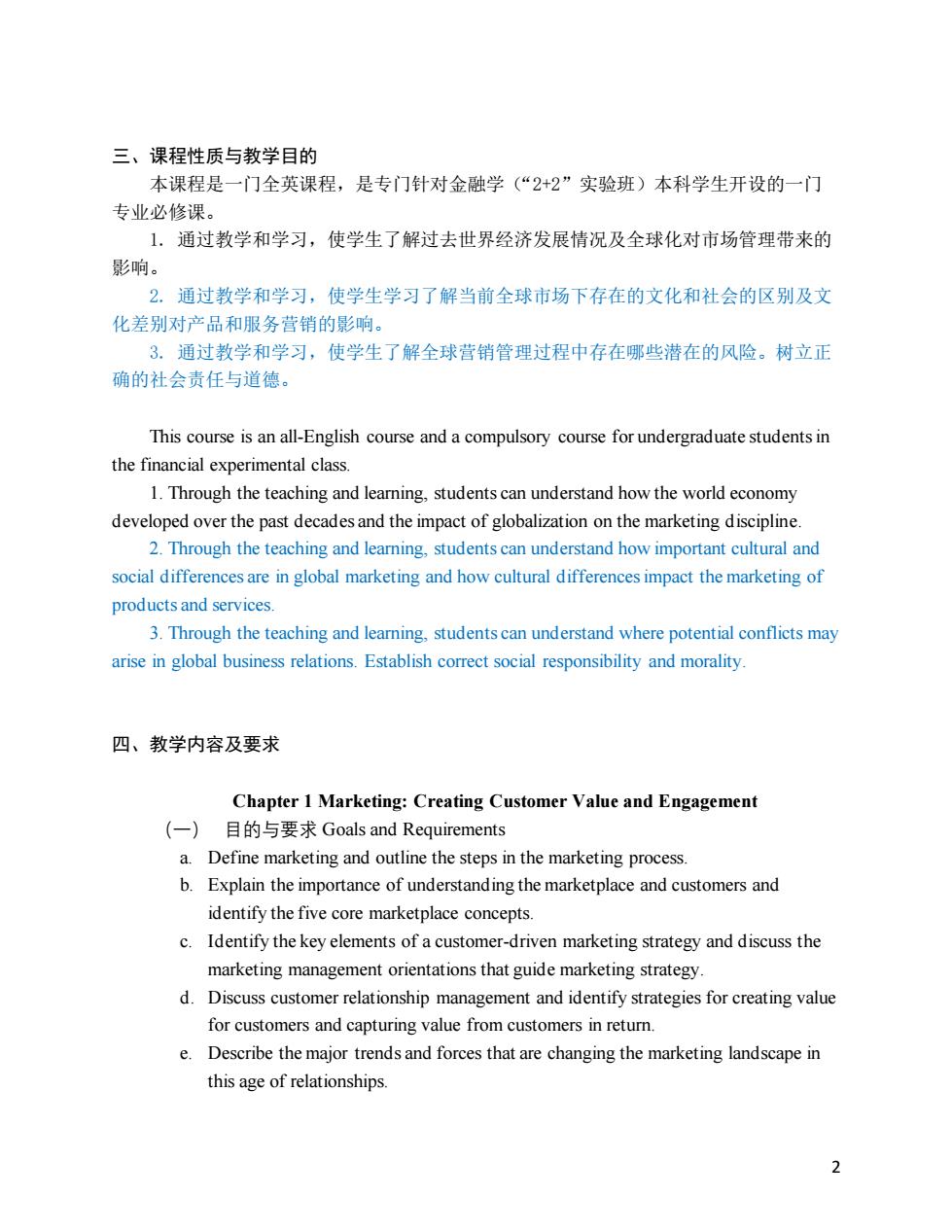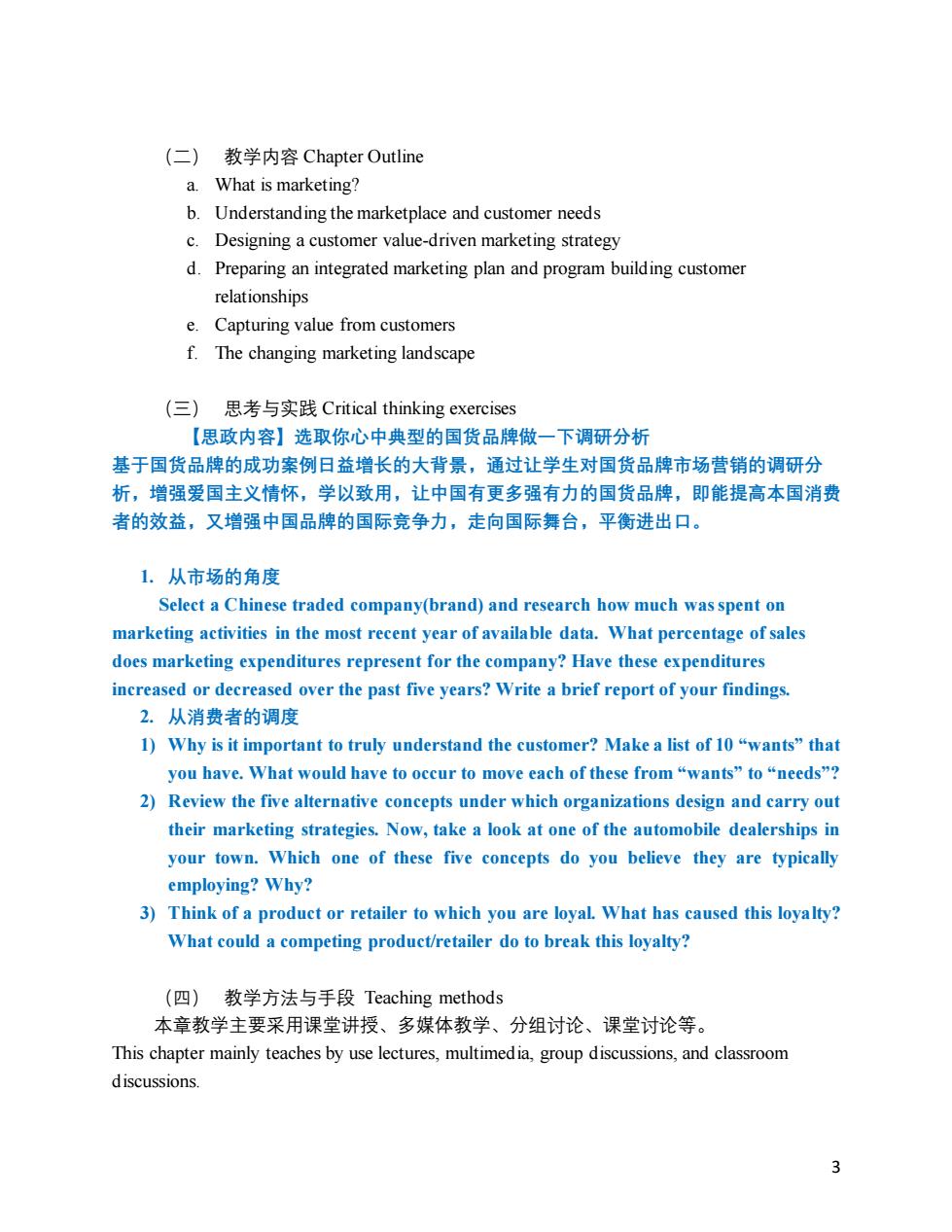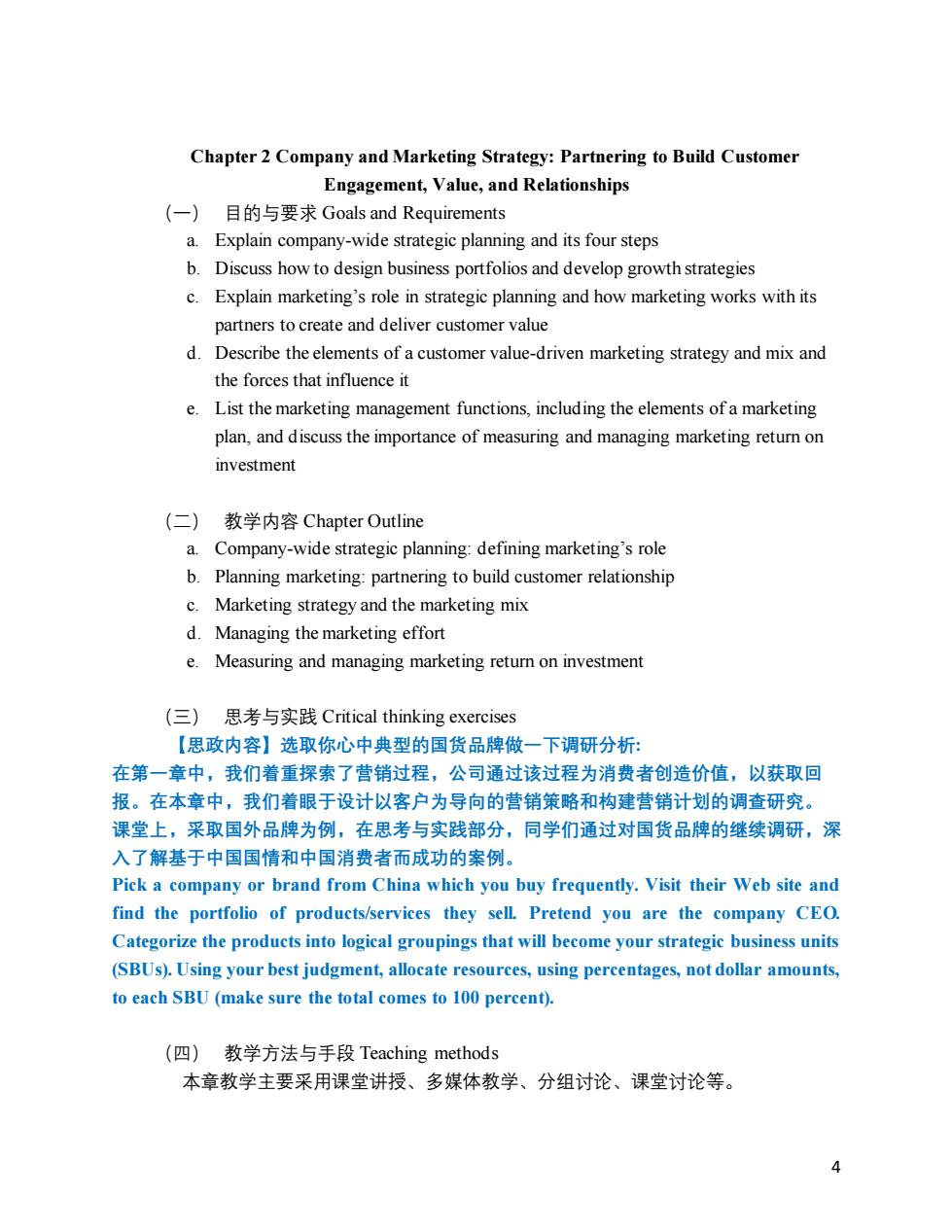
《全球市场营销管理》课程教学大纲 一、课程基本信息 课程代码:16108303 课程名称:全球市场营销管理 英文名称:Global Market Management 课程类别:专业课 学时:48 学分:3 适用对象:经济、管理类专业 考核方式:考试 先修课程:市场营销 二、课程简介 在国际化迅速发展的今天,具有全球性的思维并对国际市场与国内市场差异有所认识 是必不可少的,全球营销管理已经成为近20年来营销和国际管理领域中发展最快的部分 之一。课程会分别从全球营销导论、全球营销环境、目标市场机会的分析和评价、全球营 销战略、全球营销方案的设计与管理等方面对当前全球营销的理论和实践进行描述和总 结。 本课程将以全英文授课。同时,通过本门课的学习,希望培养学生在各种专业学习和 科学研究活动中运用英语的能力。我们可以使用英语进行学术研究,以提高交流能力,信 息获取,整合和应用能力。 With the rapid development of interationalization today,it is indispensable to have a global mindset and understand the differences between the interational market and the domestic market.Global marketing management has become one of the fastest-growing parts in marketing and international management in the past 20 years.The course will summarize the current global marketing theory and practice from the global marketing introduction,global marketing environment,target market opportunity analysis and evaluation,global marketing strategy,and global marketing plan design and management This course will be taught in English.At the same time,it is necessary to cultivate students' ability of applying English language in various professional learning and scientific research activities.We can use English to carry on academic research communication ability,information acquisition,integration and application ability
1 《全球市场营销管理》课程教学大纲 一、课程基本信息 课程代码:16108303 课程名称:全球市场营销管理 英文名称:Global Market Management 课程类别:专业课 学时:48 学分:3 适用对象:经济、管理类专业 考核方式:考试 先修课程:市场营销 二、课程简介 在国际化迅速发展的今天,具有全球性的思维并对国际市场与国内市场差异有所认识 是必不可少的,全球营销管理已经成为近 20 年来营销和国际管理领域中发展最快的部分 之一。课程会分别从全球营销导论、全球营销环境、目标市场机会的分析和评价、全球营 销战略、全球营销方案的设计与管理等方面对当前全球营销的理论和实践进行描述和总 结。 本课程将以全英文授课。同时,通过本门课的学习,希望培养学生在各种专业学习和 科学研究活动中运用英语的能力。我们可以使用英语进行学术研究,以提高交流能力,信 息获取,整合和应用能力。 With the rapid development of internationalization today, it is indispensable to have a global mindset and understand the differences between the international market and the domestic market. Global marketing management has become one of the fastest-growing parts in marketing and international management in the past 20 years. The course will summarize the current global marketing theory and practice from the global marketing introduction, global marketing environment, target market opportunity analysis and evaluation, global marketing strategy, and global marketing plan design and management. This course will be taught in English. At the same time, it is necessary to cultivate students' ability of applying English language in various professional learning and scientific research activities. We can use English to carry on academic research communication ability, information acquisition, integration and application ability

三、课程性质与教学目的 本课程是一门全英课程,是专门针对金融学(“2+2”实验班)本科学生开设的一门 专业必修课。 1.通过教学和学习,使学生了解过去世界经济发展情况及全球化对市场管理带来的 影响。 2.通过教学和学习,使学生学习了解当前全球市场下存在的文化和社会的区别及文 化差别对产品和服务营销的影响。 3.通过教学和学习,使学生了解全球营销管理过程中存在哪些潜在的风险。树立正 确的社会责任与道德。 This course is an all-English course and a compulsory course for undergraduate students in the financial experimental class 1.Through the teaching and leamning,students can understand how the world economy developed over the past decades and the impact of globalization on the marketing discipline. 2.Through the teaching and leaming,students can understand how important cultural and social differences are in global marketing and how cultural differences impact the marketing of products and services. 3.Through the teaching and learning,students can understand where potential conflicts may arise in global business relations.Establish correct social responsibility and morality. 四、教学内容及要求 Chapter 1 Marketing:Creating Customer Value and Engagement (-)目的与要求Goals and Requirements a.Define marketing and outline the steps in the marketing process. b.Explain the importance of understanding the marketplace and customers and identify the five core marketplace concepts c.Identify the key elements of a customer-driven marketing strategy and discuss the marketing management orientations that guide marketing strategy. d.Discuss customer relationship management and identify strategies for creating valu for customers and capturing value from customers in return. e.Describe the major trends and forces that are changing the marketing landscape in this age of relationships 2
2 三、课程性质与教学目的 本课程是一门全英课程,是专门针对金融学(“2+2”实验班)本科学生开设的一门 专业必修课。 1. 通过教学和学习,使学生了解过去世界经济发展情况及全球化对市场管理带来的 影响。 2. 通过教学和学习,使学生学习了解当前全球市场下存在的文化和社会的区别及文 化差别对产品和服务营销的影响。 3. 通过教学和学习,使学生了解全球营销管理过程中存在哪些潜在的风险。树立正 确的社会责任与道德。 This course is an all-English course and a compulsory course for undergraduate students in the financial experimental class. 1. Through the teaching and learning, students can understand how the world economy developed over the past decades and the impact of globalization on the marketing discipline. 2. Through the teaching and learning, students can understand how important cultural and social differences are in global marketing and how cultural differences impact the marketing of products and services. 3. Through the teaching and learning, students can understand where potential conflicts may arise in global business relations. Establish correct social responsibility and morality. 四、教学内容及要求 Chapter 1 Marketing: Creating Customer Value and Engagement (一) 目的与要求 Goals and Requirements a. Define marketing and outline the steps in the marketing process. b. Explain the importance of understanding the marketplace and customers and identify the five core marketplace concepts. c. Identify the key elements of a customer-driven marketing strategy and discuss the marketing management orientations that guide marketing strategy. d. Discuss customer relationship management and identify strategies for creating value for customers and capturing value from customers in return. e. Describe the major trends and forces that are changing the marketing landscape in this age of relationships

(二)教学内容Chapter Outline a.What is marketing? b.Understanding the marketplace and customer needs c.Designing a customer value-driven marketing strategy d.Preparing an integrated marketing plan and program building customer relationships e.Capturing value from customers f.The changing marketing landscape (三)思考与实践Critical thinking exercises 【思政内容】选取你心中典型的国货品牌做一下调研分析 基于国货品牌的成功案例日益增长的大背景,通过让学生对国货品牌市场营销的调研分 析,增强爱国主义情怀,学以致用,让中国有更多强有力的国货品牌,即能提高本国消费 者的效益,又增强中国品牌的国际竞争力,走向国际舞合,平衡进出口。 1.从市场的角度 Select a Chinese traded company(brand)and research how much was spent on marketing activities in the most recent year of available data.What percentage of sales does marketing expenditures represent for the company?Have these expenditures increased or decreased over the past five years?Write a brief report of your findings. 2.从消费者的调度 1)Why is it important to truly understand the customer?Make a list of 10 "wants"that you have..What would have to occur to move each of these from“wants'”to“needs”g 2)Review the five alternative concepts under which organizations design and carry out their marketing strategies.Now,take a look at one of the automobile dealerships in your town.Which one of these five concepts do you believe they are typically employing?Why? 3)Think of a product or retailer to which you are loyal What has caused this loyalty? What could a competing product/retailer do to break this loyalty? (四)教学方法与手段Teaching methods 本章教学主要采用课堂讲授、多媒体教学、分组讨论、课堂讨论等。 This chapter mainly teaches by use lectures,multimedia,group discussions,and classroom discussions
3 (二) 教学内容 Chapter Outline a. What is marketing? b. Understanding the marketplace and customer needs c. Designing a customer value-driven marketing strategy d. Preparing an integrated marketing plan and program building customer relationships e. Capturing value from customers f. The changing marketing landscape (三) 思考与实践 Critical thinking exercises 【思政内容】选取你心中典型的国货品牌做一下调研分析 基于国货品牌的成功案例日益增长的大背景,通过让学生对国货品牌市场营销的调研分 析,增强爱国主义情怀,学以致用,让中国有更多强有力的国货品牌,即能提高本国消费 者的效益,又增强中国品牌的国际竞争力,走向国际舞台,平衡进出口。 1. 从市场的角度 Select a Chinese traded company(brand) and research how much was spent on marketing activities in the most recent year of available data. What percentage of sales does marketing expenditures represent for the company? Have these expenditures increased or decreased over the past five years? Write a brief report of your findings. 2. 从消费者的调度 1) Why is it important to truly understand the customer? Make a list of 10 “wants” that you have. What would have to occur to move each of these from “wants” to “needs”? 2) Review the five alternative concepts under which organizations design and carry out their marketing strategies. Now, take a look at one of the automobile dealerships in your town. Which one of these five concepts do you believe they are typically employing? Why? 3) Think of a product or retailer to which you are loyal. What has caused this loyalty? What could a competing product/retailer do to break this loyalty? (四) 教学方法与手段 Teaching methods 本章教学主要采用课堂讲授、多媒体教学、分组讨论、课堂讨论等。 This chapter mainly teaches by use lectures, multimedia, group discussions, and classroom discussions

Chapter 2 Company and Marketing Strategy:Partnering to Build Customer Engagement,Value,and Relationships (-)目的与要求Goals and Requirements a.Explain company-wide strategic planning and its four steps b.Discuss how to design business portfolios and develop growth strategies c.Explain marketing's role in strategic planning and how marketing works with its partners to create and deliver customer value d.Describe the elements of a customer value-driven marketing strategy and mix and the forces that influence it e.List the marketing management functions,including the elements ofa marketing plan,and discuss the importance of measuring and managing marketing return on investment (二)教学内容Chapter Outline a.Company-wide strategic planning:defining marketing's role b.Planning marketing:partnering to build customer relationship c.Marketing strategy and the marketing mix d.Managing the marketing effort e.Measuring and managing marketing return on investment (三)思考与实践Critical thinking exercises 【思政内容】选取你心中典型的国货品牌做一下调研分析: 在第一章中,我们着重探索了营销过程,公司通过该过程为消费者创造价值,以获取回 报。在本章中,我们着眼于设计以客户为导向的营销策略和构建营销计划的调查研究。 课堂上,采取国外品牌为例,在思考与实践部分,同学们通过对国货品牌的继续调研,深 入了解基于中国国情和中国消费者而成功的案例。 Pick a company or brand from China which you buy frequently.Visit their Web site and find the portfolio of products/services they sell Pretend you are the company CEO. Categorize the products into logical groupings that will become your strategic business units (SBUs).Using your best judgment,allocate resources,using percentages,not dollar amounts, to each SBU (make sure the total comes to 100 percent). (四)教学方法与手段Teaching methods 本章教学主要采用课堂讲授、多媒体教学、分组讨论、课堂讨论等
4 Chapter 2 Company and Marketing Strategy: Partnering to Build Customer Engagement, Value, and Relationships (一) 目的与要求 Goals and Requirements a. Explain company-wide strategic planning and its four steps b. Discuss how to design business portfolios and develop growth strategies c. Explain marketing’s role in strategic planning and how marketing works with its partners to create and deliver customer value d. Describe the elements of a customer value-driven marketing strategy and mix and the forces that influence it e. List the marketing management functions, including the elements of a marketing plan, and discuss the importance of measuring and managing marketing return on investment (二) 教学内容 Chapter Outline a. Company-wide strategic planning: defining marketing’s role b. Planning marketing: partnering to build customer relationship c. Marketing strategy and the marketing mix d. Managing the marketing effort e. Measuring and managing marketing return on investment (三) 思考与实践 Critical thinking exercises 【思政内容】选取你心中典型的国货品牌做一下调研分析: 在第一章中,我们着重探索了营销过程,公司通过该过程为消费者创造价值,以获取回 报。在本章中,我们着眼于设计以客户为导向的营销策略和构建营销计划的调查研究。 课堂上,采取国外品牌为例,在思考与实践部分,同学们通过对国货品牌的继续调研,深 入了解基于中国国情和中国消费者而成功的案例。 Pick a company or brand from China which you buy frequently. Visit their Web site and find the portfolio of products/services they sell. Pretend you are the company CEO. Categorize the products into logical groupings that will become your strategic business units (SBUs). Using your best judgment, allocate resources, using percentages, not dollar amounts, to each SBU (make sure the total comes to 100 percent). (四) 教学方法与手段 Teaching methods 本章教学主要采用课堂讲授、多媒体教学、分组讨论、课堂讨论等

This chapter mainly teaches by use lectures,multimedia,group discussions,and classroom discussions. Chapter 3 Analyzing the Marketplace and Customer Value (一)目的与要求Goals and Requirements a.Describe the environmental forces that affect the company's ability to serve its customers b.Explain how changes in the demographic and economic environments affect marketing decisions c.Identify the major trends in the firm's natural and technological environments d.Explain the key changes in the political and cultural environments e.Discuss how companies can react to the marketing environment (二)教学内容Chapter Outline a.The microenvironment:the company,suppliers,marketing intermediaries, competitors,publics,and customers; b.The macroenvironment:the demographic environment,the economic environment, the natural environment,the technological environment,the political and social environment,and the cultural environment. (三)思考与实践Critical thinking exercises 【思政内容】西方核心价值观&社会主义核心价值观 通过对比中西方市场的微观环境和宏观环境,正确看待中西方文化差异带来的影 响。弘扬中华传统文化和社会义核心价值观。 对欧美引进的咖啡(如星巴克,costa)和中国本土的瑞幸咖啡做对比: 1.Define the marketing environment for Starbucks and Luckin Coffee.Do the comparison form serval aspects.Keep in mind that a company's marketing environment consists of the actors and forces outside marketing that affect marketing management's ability to build and maintain successful relationships with target customers. 2.Whatare the fundamental differences between consumer markets,business markets,and reseller markets? (四)教学方法与手段Teaching methods 本章教学主要采用课堂讲授、多媒体教学、分组讨论、课堂讨论等。 This chapter mainly teaches by use lectures,multimedia,group discussions,and classroom discussions
5 This chapter mainly teaches by use lectures, multimedia, group discussions, and classroom discussions. Chapter 3 Analyzing the Marketplace and Customer Value (一) 目的与要求 Goals and Requirements a. Describe the environmental forces that affect the company’s ability to serve its customers b. Explain how changes in the demographic and economic environments affect marketing decisions c. Identify the major trends in the firm’s natural and technological environments d. Explain the key changes in the political and cultural environments e. Discuss how companies can react to the marketing environment (二) 教学内容 Chapter Outline a. The microenvironment: the company, suppliers, marketing intermediaries, competitors, publics, and customers; b. The macroenvironment: the demographic environment, the economic environment, the natural environment, the technological environment, the political and social environment, and the cultural environment. (三) 思考与实践 Critical thinking exercises 【思政内容】西方核心价值观&社会主义核心价值观 通过对比中西方市场的微观环境和宏观环境,正确看待中西方文化差异带来的影 响。弘扬中华传统文化和社会义核心价值观。 对欧美引进的咖啡(如星巴克,costa)和中国本土的瑞幸咖啡做对比: 1. Define the marketing environment for Starbucks and Luckin Coffee. Do the comparison form serval aspects. Keep in mind that a company’s marketing environment consists of the actors and forces outside marketing that affect marketing management’s ability to build and maintain successful relationships with target customers. 2. What are the fundamental differences between consumer markets, business markets, and reseller markets? (四) 教学方法与手段 Teaching methods 本章教学主要采用课堂讲授、多媒体教学、分组讨论、课堂讨论等。 This chapter mainly teaches by use lectures, multimedia, group discussions, and classroom discussions